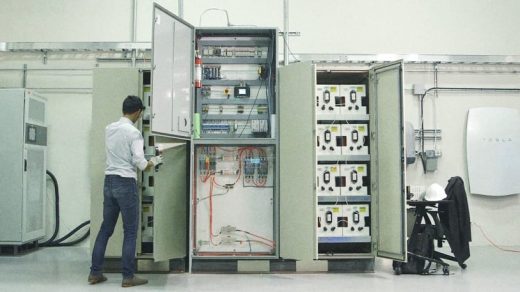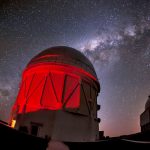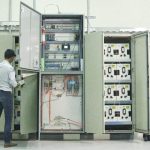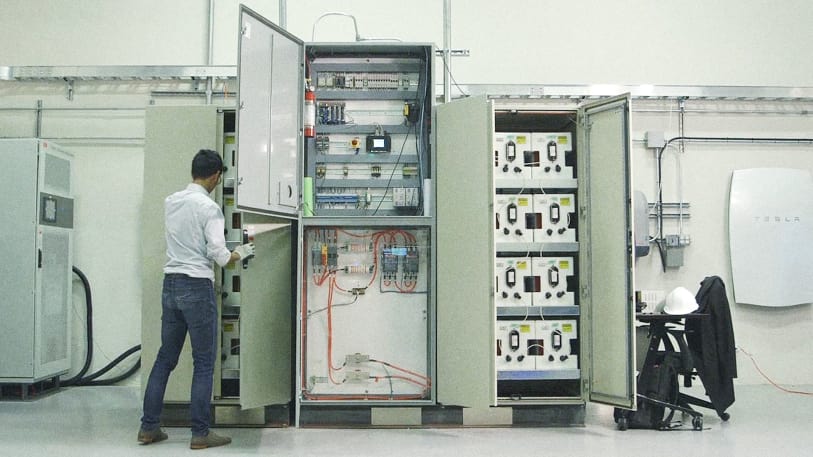Visualizing The Electric Grid In Real Time, And Other World Changing Ideas In Energy
Electricity grids are some of the most complex systems ever invented. Serving millions of homes and businesses across thousands of miles of transmission and distribution lines, they’re an incredible tangle of electron flows. And, compared to other infrastructure, they’re generally not very up to date: much of the design still dates back to Thomas Edison and Nikola Tesla.
Operators have a surprisingly limited grasp of how power is shifting about at any moment. Take my home in Brooklyn. Because the local utility (Con Edison) has yet to install two-way “smart meters” in my area, a worker has to come to the door every few months and ask to read the meter. The company doesn’t know how much power I’m using hour to hour.
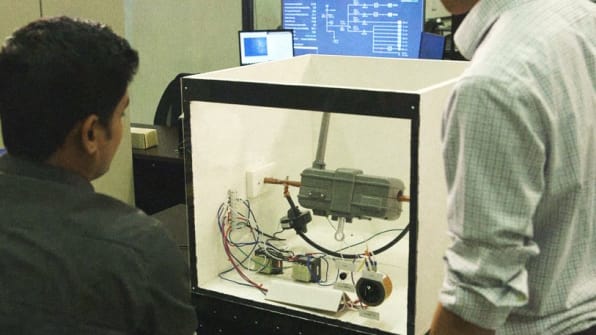
This lack of grid visibility creates a challenge as we add more “distributed” resources, like solar, wind, batteries and electric vehicles, to the network. The grid is evolving from a one-way system, where power flows down to your home from large plants, to a two-way system, where power goes back and forth (say when rooftop solar panels export excess power to the grid). At the same time, solar and wind aren’t constant sources. They vary in usefulness depending on the time of day and the state of the weather.
That’s why we badly need software like GridOS, which recently won the energy category in Fast Company’s World Changing Ideas contest. (You can read more about the other finalists below.) Developed in Toronto by Opus One Solutions, the grid modeling technology gives grid operators more visibility into power flows, allowing them to identify inefficiencies, balance supply and demand, and make better trading decisions.
“The grid is very blind,” says Joshua Wong, Opus One Solutions’ founder and CEO. “What you can’t see, you can barely control, and what you can’t control, you can’t optimize and put a value on. When you can’t put a price [on a resource], you don’t know how to modernize the grid.”
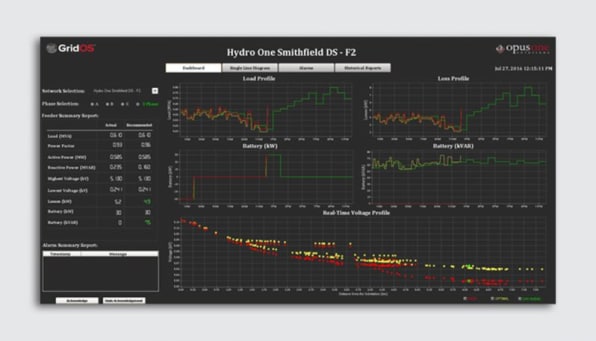
The value of a distributed, or “edge,” resource is relative and situational, and dictated only partly by its installation cost. A wind turbine is likely to be worth more in the middle of the day (when demand is high), or when a traditional power plant isn’t available (maybe it’s down for maintenance). GridOS shows the marginal value of an edge resource at any moment, enabling better hour-to-hour and day-ahead management, and better planning. Operators can see where they might need to upgrade a transmission line, or put in more energy storage to handle excess supply (say, when turbines are generating more power than consumers need).
Wong founded Opus One in 2011, and has since built several micro-grids in Ontario, including one athletes village at the 2015 Pan-American Games. Wong says these projects helped inform GridOS’s sophisticated algorithms and grid modeling techniques. Opus One Solutions is currently building a micro-grid on the Buffalo Niagara Medical Campus, as part of New York’s experimental Reforming the Energy Vision (REV) program. The project prices the value of distributed resources and aims to help utilities integrate renewables more effectively. REV reforms the economics of the New York’s power industry, so utilities have greater incentives to use solar and wind.
In the long term, generating power from renewables isn’t likely to be a problem. By 2050, sources like solar, wind and geothermal can meet 80% of demand, a report from the National Renewable Energy Laboratory showed last year. (And that’s just with currently available technologies, never mind what inventions might emerge from the energy industry over the next few decades). But enabling the grid to cope with that much distributed generation will require a lot of investment in new infrastructure and more advanced planning systems, like the one GridOS offers.
The end goal, says Wong, is a fully “transactive” energy system, where every home, business, electric vehicle, and generation site works in concert, constantly trading power back and forth, depending on availability and need. “The level of participation needs to increase,” he says. “The network is always more valuable than what anyone can do on their own.”
Here’s more about the finalists in the energy category:
GE hydropower turbines
by GE Renewable Energy and Max Bögl Wind AG
Located high in the Swabian-Franconian Forest in southern Germany, GE’s wind-hydro energy storage project is like a giant battery. When four giant 584-feet turbines generate more electricity than the local grid needs, the power is used to pump water up a mountainside into a series of reservoirs. When the grid needs electricity, the water is released, so it runs through generators at the bottom. The project offers an elegant solution to wind power’s intermittency–the way turbines may generate too little power, or too much, raising headaches for grid operators.
Sandstone Energy 10X
by SolarReserve
SolarReserve already has one massive solar thermal energy site: the $ 1 billion Crescent Dunes project in Tonopah, Nevada. It has 10,347 tracking mirrors concentrating energy onto a central concrete tower full of high-temperature molten salt. The proposed Sandstone Energy 10X would raise things to Hoover Dam dimensions, with 20 gigawatt-hours of energy storage, or enough power for 1 million Californian homes.
ChargePoint Home
by ChargePoint
ChargePoint offers more than 30,000 public charging for electric vehicles. But people also need to charge at home. This product, designed for a garage, offers 25 miles per charging hour and comes with a mobile app, so you can keep track of your car’s battery levels.
Totem
by Totem Power
Developed by a New York company, this solar-powered “utility pole” incorporates WiFi, a 4G mobile connection, electric vehicle charging, street lighting and energy storage. It’s stylish public infrastructure with multiple uses.
d.light A1
by Ideo.org
Too many the world’s poor still rely on kerosene for lighting, putting their health–and too much of their income–at risk. This classic solar lamp, the first of its kind, has “empowered over 3 million lives,” according to Ideo.org, which designed it in 2014. The d.light is marketed by a social enterprise of the same name.
Solar savings for all
by Arcadia Power
One million homes now have rooftop solar. But, while that’s impressive, it’s still only a small sliver of the potential (about 1% of utility customers). Almost 80% of residential power customers can’t get solar because they don’t own their home, they don’t have the right type of roof, or there’s too much shading over their property. Arcadia’s community program allows people to buy into local solar projects on a subscription basis.
Smart Green Tower
by Frey Architekten
Conceived by a German architecture firm, the Smart Green Tower generates and stores all its own electricity. On the outside is a glass photovoltaic facade. Inside is a massive battery. The building is due to be constructed in Freiburg im Breisgau, in south-west Germany, in 2017. It could become part of a local mini-grid, says the developer, playing a supply-and-demand balancing role.
AMIE 1.0
by Oak Ridge National Laboratory, the University of Tennessee, and Skidmore, Owings & Merrill
The Additive Manufacturing Integrated Energy project (or AMIE) is a combined 3D-printed house and 3D-printed car. Made with a series of low-weight, ultra-engineered materials, the two parts wirelessly share renewable power, making for a highly-efficient, low-waste whole.
Orison Tower and Orison Panel
by Orison
Orison makes sleek residential energy storage devices, allowing homeowners to bank power when it’s cheapest. The Orison Tower and Orison Panel offer backup in case of a blackout, says the company. And they also help manage the wider electric grid by charging during times of low demand and discharging during higher-demand periods.
GoSun Grill
by GoSun
You can cook more food than you might think with this portable solar cooker: everything from meat and vegetables to soup and breads, according to the manufacturer. Described as a “turbo-crockpot,” the oven has parabolic reflectors on the outside, which draw solar heat to a central metal vacuum tube that gets as hot as 550°F.
Modular Indoor Micro-Climate (MIMiC)
by Rensselaer Polytechnic Institute Center for Architecture Science and Ecology
Still in development, this micro-climate control technology aims to offer localized heating and cooling, cutting waste and delivering personalized temperatures. Developed by the Center for Architecture Science and Ecology (CASE), a research collaboration between the Rensselaer Polytechnic Institute and Skidmore, Owings & Merrill (SOM), a design and engineering firm, the system splits a room into zones, letting users choose between cooling, heating, and ventilation modes using an app.
The Kathleen Grimm School for Leadership and Sustainability at Sandy Ground (P.S. 62)
by Skidmore, Owings & Merrill
Also designed by SOM, this school claims to be the first in New York to generate more onsite energy than it uses. With 40 roof mounted solar panels to heat water, geothermal heating and energy-efficient equipment, the 68,000-square-foot, two-story school in Staten Island educates 444 pre-kindergarten through fifth-grade students. SOM says it uses 50% less energy than a typical New York City school.
(58)

